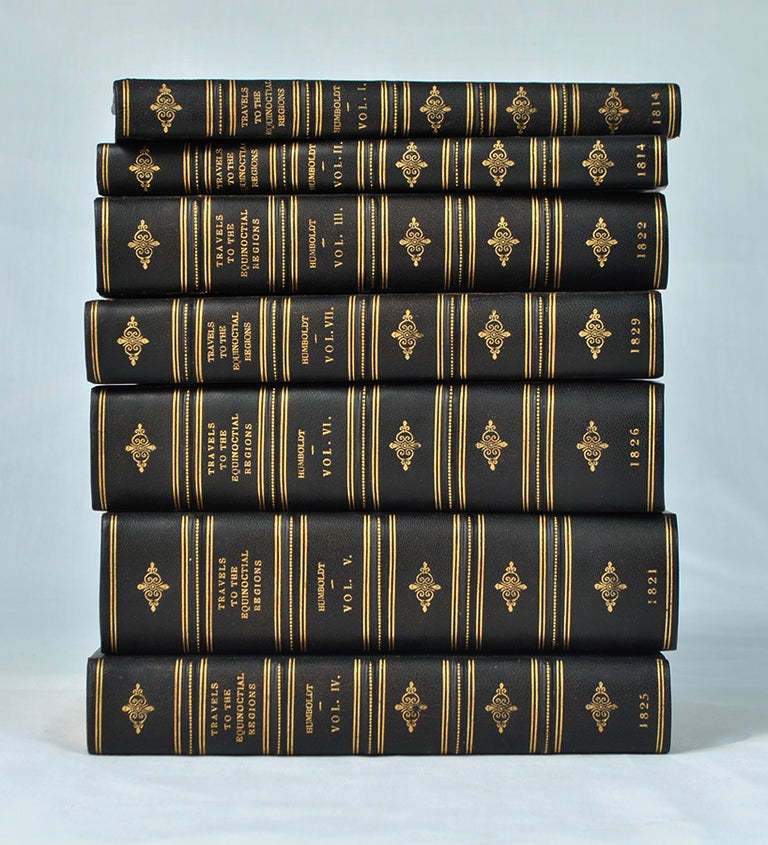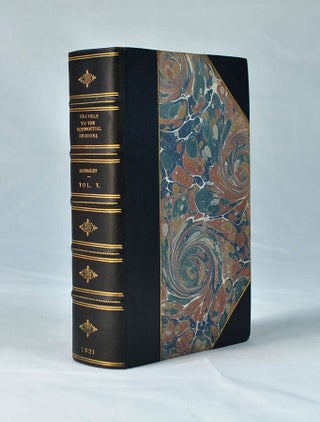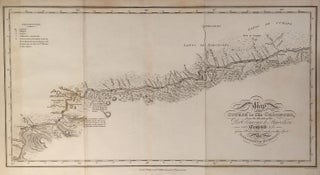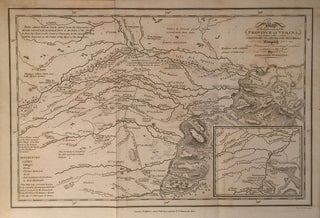Personal Narrative of Travels to the Equinoctial Regions of the New Continent, During the Years 1799–1804.
London: printed for Longman, Hurst, Rees, Orme, and Brown, Paternoster Row; J. Murray, Albemarle Street; and H. Colburn, Conduit Street. W. Pople, printer. 1814–1829. Half black morocco and marbled paper over boards, t.e.g., raised bands, gilt ornaments, author, title, volume number, and year in 6 compartments. Vol. 1: [i–v], vi–xi, [i]–li, [1]–289; vol. 2: [1]–299; vol. 3: 575 pp., 2 foldout charts and 3 foldout maps; vol. 4: [1]–573; vol. 5: [1]–865, errata, [1]–3; vol. 6: foldout map, [title], [1 blank], [editor’s ad iii]–v, [1]–845, [1 blank], [2 pp. ads]; vol. 7: [1]–482. Alexander von Humboldt’s account of his monumental scientific expedition to South America and Cuba. Originally published in French between 1814 and 1825, this is the first edition in English, except volumes 3 and 4 which are stated second editions. Alexander von Humboldt, "perhaps one of the greatest scholars of all time… [and] hailed in his time as one of the most famous men in Europe," was not only a pioneering naturalist and explorer, but also lay the foundations both for the science of comparative climatology and for breakthroughs in our understanding of the Earth's geomagnetic field. The English translation of his Personal Narrative was, a generation later, a fundamentally important text to Darwin himself, whose own journal aboard the Beagle "can be read as a sort of continual intellectual dialogue with Humboldt" (van Wyhe). Humboldt's expedition—undertaken with French botanist Aimé Bonpland shortly after his stint managing mines for the Prussian government—lasted five years and took him some six thousand miles, from Caracas, San Carlos, and Angostura in modern-day Venezuela, to various locations in modern-day Cuba, Peru, Ecuador, and Colombia. He and Bonpland not only recorded natural history, but took measurements of barometric pressure and the Earth’s geomagnetic field. Off the west coast of South America, Humboldt studied the cold ocean current which would be named after him, though it is now known as the Peru Current. Helen Maria Williams' English translation renders Humboldt's prose as clear, vivid, and elegant, readily communicating the explorer’s obvious scientific excitement and aesthetic appreciation of the natural wonders surrounding him. Humboldt spent the final year of his voyage in Mexico City writing his History of New Spain before continuing to the U.S., where he was entertained by Jefferson, and then returning to Europe. He remained in Paris for as long as his finances (which had been greatly depleted by the voyage) allowed, collaborating with other scientists and offering instrumental support and encouragement to such young thinkers as Louis Agassiz. A landmark work of scientific exploration. REFERENCES: Sabin 33770; Howgego, Raymond John, Encyclopedia of Exploration to 1800, H120 & H121; van Wyhe, John, "Humboldt's Personal narrative and its influence on Darwin," The Complete Work of Charles Darwin Online; Kellner, Charlotte L., "Alexander von Humboldt," Encyclopedia Britannica. CONDITION: Good, volumes moderately rubbed, occasional foxing and toning, mainly at first and last few leaves and fore-edges.
Item #3835
Sold





